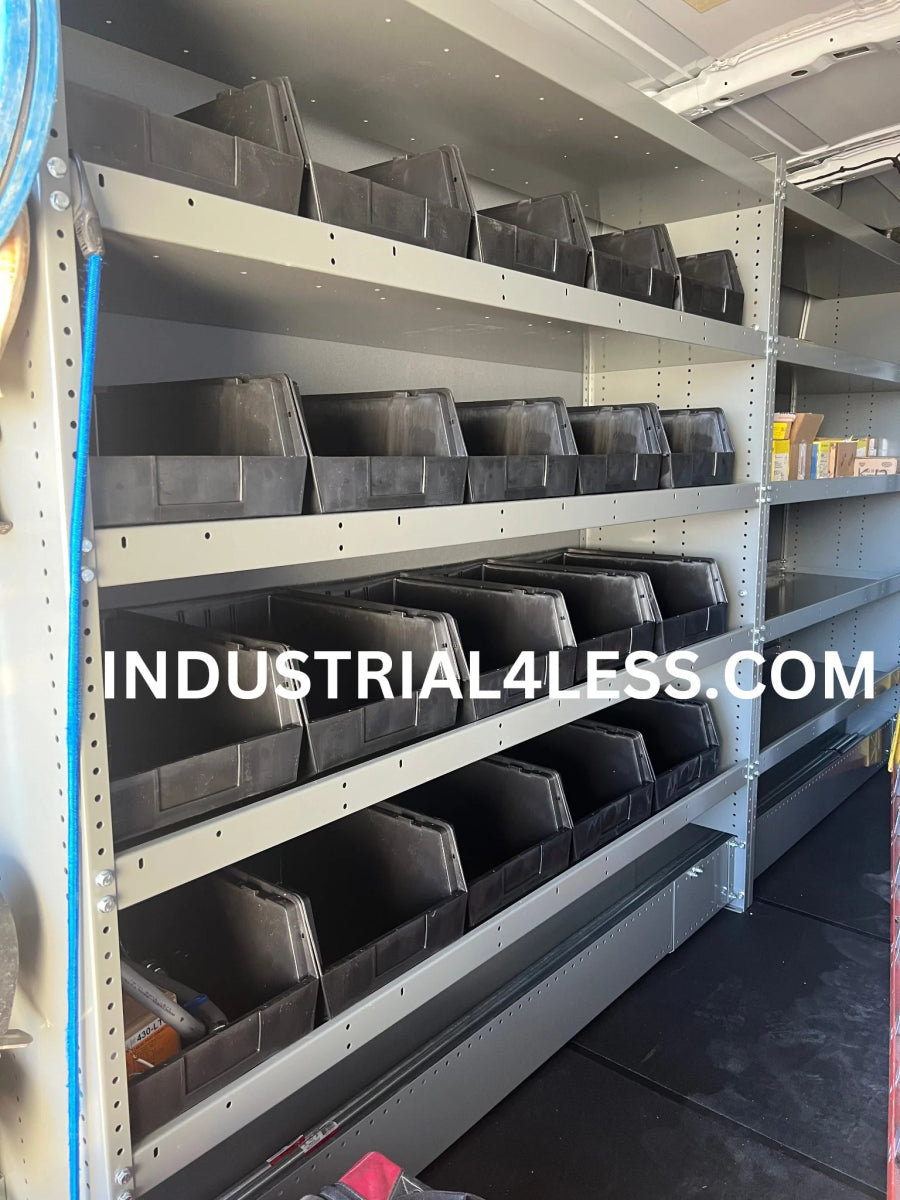If you've already read our first post on service truck storage solutions, the post below will explain the differences between some of the older-style setups and configurations compared to the newest and latest options that include different finishes, sizes and more.
Traditional Setups vs. Shelving with Storage Bins
Traditional Setups:
- Loose Item Storage: In the past, many service vans simply stored items loosely on shelves or even just thrown in the back of the van. This obviously leads to chaos as the items wound up all over the place, causing loss of product and damage to product, This method often leads to tools and equipment moving around during transit, increasing the likelihood of damage.
- Custom Built Solutions: Another option was to utilize custom-built wooden shelves that were specially created and cut to size based on your requirements. While the customization was great, the wooden shelves often get moldy or rotted due to high humidity and moisture levels. Also, once a custom wood shelf was designed, any changes needed (such as adding more shelves) required a completely new unit to be designed from scratch, causing high costs and longer lead times.
- Toolboxes and Bags: Popular tool boxes (similar to milwaukee tool's packout containers) or bags for storage was common but inefficient. Workers had to remember the contents of each box or bag, leading to increased time searching for items and a higher chance of forgetting essential tools. Also, using traditional tool boxes and systems alike limits the customization options that other solutions like plastic shelf bins offer.
- Inefficiency: The time spent searching for tools in unorganized setups directly translates to lost productivity and delayed service times.
- Increased Risk of Damage: Without a more secure solution, tools and parts are more susceptible to damage during transport.
- Lack of Scalability: As businesses grow, these traditional methods do not easily adapt to changing needs, requiring significant overhauls for expansion or modification.
Open Front Shelf Bins for Storage:
-
Organized Item Storage: Within the more recently outfitted service vans and trucks, you'll often find that they've been outfitted with metal/steel shelving units and open front plastic storage bins. The bins used are perfectly designed to fit the shelves with the intent of maximizing the usable storage space. Utilizing steel shelving with neatly labeled plastic bins, workers maintain the ability to quickly locate and retrieve the specific parts needed at any given moment.
- Quick Access and Reduced Search Time: Clearly labeled van storage bins on shelving units allow workers to quickly identify and retrieve the tools or parts they need, allowing them to perform their service quicker, leading to happier customers and increased capacity to take on more clients.
- Minimized Damage and Loss: Each item has a designated spot within a bin, reducing movement during transit and lowering the risk of damage or loss.
- Adaptability: Work van storage bins and shelves are adjustable, allowing you to easily swap bins for different sizes or add more shelves as needed. The ability to adapt your configuration means that no matter how industries change, you'll never be caught off guard with regards to changing business needs or inventory sizes.
- Professional Appearance: A well-organized van or truck not only improves efficiency but also presents a professional image to clients, enhancing trust and credibility.

Dividable Grid Containers for Parts Segregation and Compartmentalization:
- Serialized Storage: Another very popular style of storage bin for work vans are dividable grid containers. Workers utilize dividable grid containers to meticulously categorize and segregate various components and parts, ensuring easy access and efficient inventory management. Each bin is labeled and sorted to enhance the workflow in maintenance and assembly tasks.
- Streamlined Organization and Restocking: Individual compartments within these grid containers provide a streamlined approach to component organization, significantly reducing time spent searching for scattered or missing parts.
- Customization Galore: Dividable grid containers are highly customizable, allowing you to create as many (or few) compartments as needed for your specific setup. Length and width dividers allow you to create the exact compartment size required for any component, whether small screws or larger pipes.
- Visual separation helps with quick inventory checks and restocking. It's going to be very easy to spot when items are low or out of inventory by using dividable grid containers.

DIY Van Shelves or Commercial Outfitters
Many commercial van outfitters offer all-in-one services to convert standard ans into well equipped mobile workstations. While these turnkey solutions are convenient, they come with a significant price tag and a lack of options. The high costs encompasses not only the physical components—such as shelving units, storage bins, and other organizational systems—but also the expertise and labor involved in the customization process. If you're the kind of person who prefers a DIY project, you'll surely save a large amount of money by working with a specialized shelving and bin provider (like Industrial 4 Less) who offers a much more extensive variety of sizes, styles and functionality choices, but also a much lower cost since you're removing the commercial outfitter's markup on the products they're simply buying from us. And by the way, we've worked closely with enough plumbers, electricians, air conditioning repair companies, contractors to know exactly what works best for each specific situation.
Head to Head Comparison
Commercial Outfitters:
- Pros:
- Convenience - Turnkey
- Professional design
- Cons:
- Higher costs
- Long lead times
- Limited options
- Inability to change/adapt system once in place
- Higher costs due to customization and full-service outfitting.
DIY:
- Pros:
- Larger selection of shelves and bins. Sizes, colors, styles and functionality.
- Lower costs purchasing direct from an authorized distributor rather than a re-seller applying a markup and limiting selection.
- Faster lead times. Bins and shelves can ship out to you within one day of ordering. Compared to the typical months lead time from once a commercial outfitter is contacted.
- Expert guidance from companies who have been selling to DIY enthusiasts AND commercial outfitters for years. We know what works.
- Cons:
- Not turnkey. You have to do the installation and assembly yourself. But you said you like DIY projects anyway, so is this really a negative?
The choice between commercial outfitters and specialized bin and shelving providers ultimately depends on the specific needs, budget, and preferences of the business or individual. While commercial outfitters offer the convenience of a ready-to-use setup, those willing to invest a bit of time and effort in a DIY approach can benefit from the tailored solutions, savings, and satisfaction of building a workspace that perfectly suits their needs.
Read other blog posts discussing storage bins, containers and shelving for work vans and service trucks:
Products discussed in this post:

